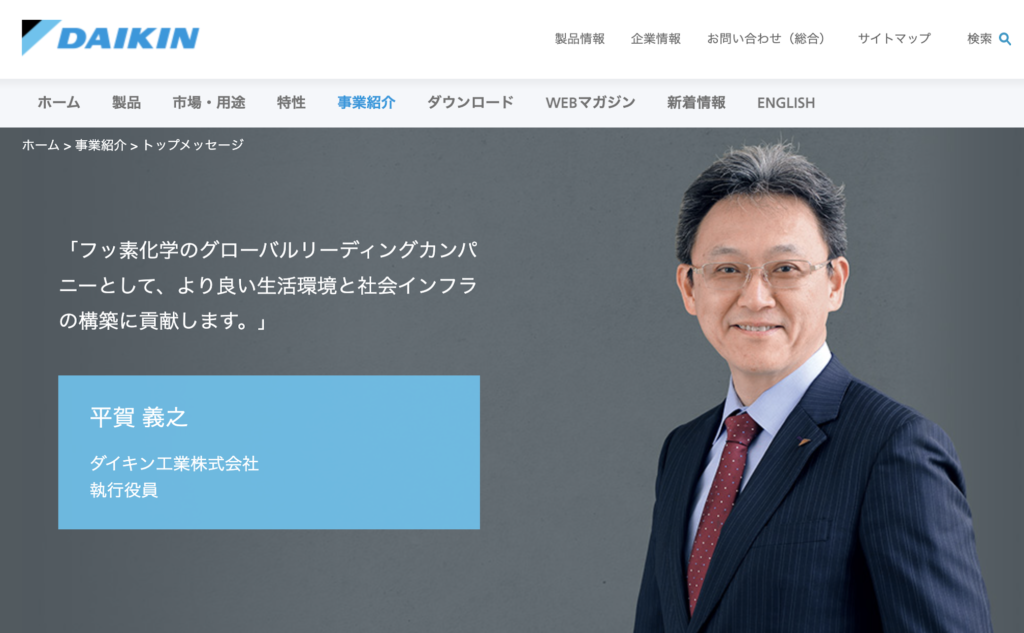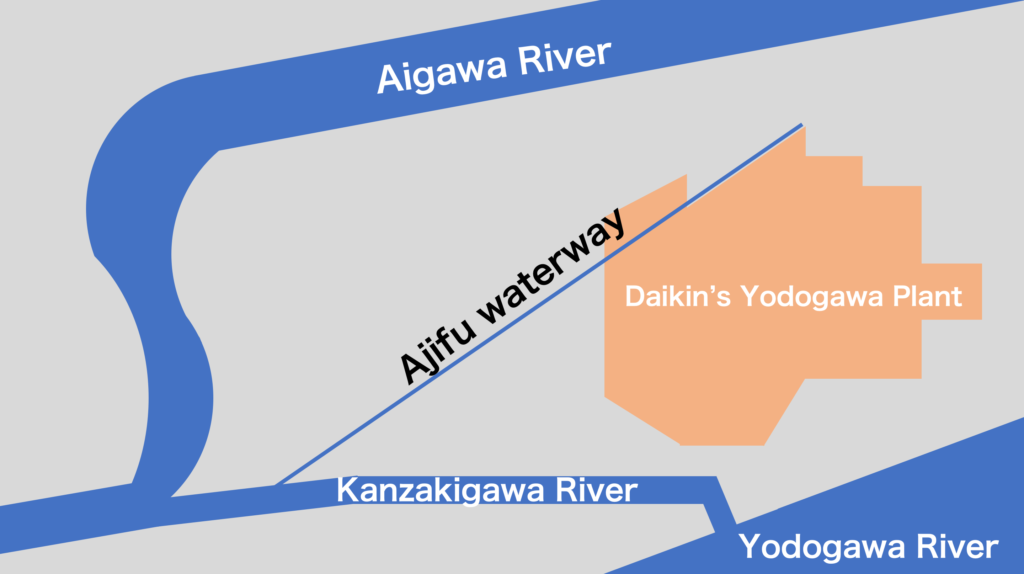Daikin Management Talks Nonsense, Unwilling to Admit the Danger of PFOA (23)
2022.12.19 18:25 Nanami Nakagawa
I acquired confidential documents of Daikin Industries in April of 2022. Until now, Daikin has held the opinion that it “may be one of the causes” for the PFOA pollution in the Settsu City, Osaka Prefecture, indicating the possibility that it has nothing to do with the pollution. However, the documents prove otherwise.
For example, according to the confidential documents, the amount of PFOA emitted from the Yodogawa plant, data Daikin has stubbornly refused to disclose, proves that Settsu is by far the most polluted area in Japan.
It also stated that for years, PFOA had been discharged to the waterway the locals used for agriculture.
Nevertheless, Daikin claims it destroyed the documents as reported in the last article.
When I showed the documents and pursued the management, they asked about PFOA instead. “Is it dangerous?“
Executive officer of the Chemicals Division ignorant of PFOA emission amount.
On June 7, 2022, Tansa editor-in-chief Watanabe and I interviewed the following management members at Daikin headquarters. Five days prior, I visited the house of Daikin Chairman Inoue where he refused to be interviewed and left the matter to his subordiantes.
Yoshiyuki Hiraga, Executive Officer
Satoshi Komatsu, Senior Manager, Global Advocacy Planning Dept., Chemicals Div.
Toru Abe, Department Manager, PR Group, Corporate Communication Dept.
The confidential documents Daikin claimed to destroy show the amount of PFOA emission in the fiscal year of 2002. The Yodogawa Plant discharged 12 tons of PFOA a year off-site. According to Akio Koizumi, a professor emeritus at Kyoto University and a pioneer of PFOA research in Japan, the amount confirms the high concentration of contamination in Settsu.
However, this data is only for the fiscal year of 2002. Daikin manufactured and used PFOA for at least 45 years, from the late 1960s to 2015. I asked about the total off-site emissions to date.
Hiraga, executive officer of the Chemicals Division, answered.
“To be honest, I can only say that I don’t know the answer.”
The executive officer of the Chemicals Division did not know the emission amount. Hiraga added that he did not even know who knew the figures.
“Whether that kind of documents are left at the company. This document that you brought was destroyed so I don’t know if there is any left.”
The amount of off-site emission is highly important information in determining Daikin’s liability for pollution. If this is not clarified, it will be impossible to decide on countermeasures against the pollution spreading around Settsu.
Hiraga said, “I guess I can look for it and check if the company has a grasp on such figures.”
I asked him to contact me when he confirms the total off-site PFOA emissions. Hiraga reluctantly said, “Let me think about that.”

Yoshinori Hiraga, Executive Officer. From Daikin Industries website/ 2022.07.06
PFOA discharged into local waterways because it’s “not a regulated pollutant.”
I also asked about PFOA emissions into local waterways that were acknowledged in the confidential documents. The documents made in 2003 stated the following.
Discharged to a Settsu sewage treatment plant beginning three years ago. Until then, discharged into Kanzakigawa River via ——waterway.
In other words, until around 2000, wastewater containing PFOA was discharged directly into local waterways. The waterway mentioned is the Ajifu waterway, a wide canal that runs alongside the west wall of Daikin’s Yodogawa Plant. Until around 2000, many residents used to draw water from it to grow rice and water their crops.

Diagram of rivers and waterways near Daikin Industries’ Yodogawa Plant. Created by Hiroka Mochizuki.
I asked why it discharged wastewater containing PFOA into the Ajifu waterway.
Komatsu, manager of the External Relations Department answered, “Well, PFOA was not a regulated pollutant.”
Certainly, the manufacture and import of PFOA was banned in Japan in October 2021. But the dangers of PFOA were known to the world before the year 2000. Even if there are no regulations, PFOA should not be discharged into waterways used by local residents if they are aware of the dangers.
“Why was it discharged to the local waterways, knowing it was a dangerous substance?”
Komatsu answered, “It was before we acknowledged the danger.”
That was hard to believe.
Daikin is the world’s eight largest PFOA manufacturer. In 1978, DuPont and 3M, which are also the eight major manufacturers, suspected the dangers of PFOA and conducted experiments using monkeys. Monkeys given high doses of PFOA died within a month. In 1981, a mother who worked at a DuPont PFOA plant gave birth to a child with a birth defect.
Daikin has close ties with both DuPont and 3M. As early as 1951, DuPont had exchanges with DuPont about the Freon manufacturing method. In 1991, it established a joint venture with 3M to manufacture raw materials for fluoropolymers.
Chairman Inoue himself visited the United States in the early 1990s and was in communication with 3M leaders. It is well documented in his own book “My Resume: Believe in the power of people and go to the world” (Nikkei Business Jinbunko).
Daikin’s baffling remarks
I asked Komatsu when exactly Daikin recognized the danger of PFOA.
“We recognized the danger in 2006.”
2006 was the year EPA called on the world’s eight largest PFOA manufacturers including Daikin to abolish PFOA.
Learning the danger of PFOA in 2006, did Daikin tell the Settsu citizens that it used to discharge gallons of PFOA into waterways? PFOA is highly residual and difficult to remove once contaminated.
Komatsu answers, “We didn’t.”
Why didn’t they tell the residents? Komatsu’s response started to stray.
Komatsu just told me that they “recognized the danger in 2006.” I replied to him, “You just told me that you recognized the danger in 2006.”
“Um, I mean I’m not sure uh, when we recognized the danger.”
The interview can’t go on if the answers keep changing. I told him, “How come you’re not sure? Please bring someone who knows then.” Instead, Komatsu asked, “Is it (PFOA) dangerous?”
I never expected Daikin to ask me if PFOA is dangerous. Editor-in-chief Watanabe involuntarily exclaimed, “What is that?” I asked Komatsu, “that’s a shocking statement, but are you okay?”
Komatsu started to explain, but he didn’t get the point. Watanabe sorted out Komatsu’s remarks and confirmed, “You can’t say that there is a possibility of danger at this point,” and Komatsu asserted.
“I can’t say”
Is it appropriate to deny the danger of PFOA? In 2019, PFOA was classified as the most dangerous chemical substance in the Stockholm Convention, an international treaty ratified by Japan, and it was decided to abolish it. That is why Japan also banned its manufacture and import last year.
When we emphasized that point, Komatsu softened his expression, saying, “I don’t know if it’s dangerous.”
Still, it is far from the scientific knowledge of the world. Is it correct to say that this is not Komatsu’s personal view, but Daikin’s view? I also checked with Hiraga, the executive officer in charge of the chemicals division, and Abe, general Manager of the Public Relations Group, but their opinion that they don’t know whether PFOA is dangerous or not remained.
Daikin PR finally ignores emails
After the interview at the Daikin headquarters, I asked the following two questions again via email through public relations.
(1) Presence or absence of records of the total amount of PFOA released outside the premises from the Yodogawa Plant
(2) Possibility of disclosure if there is a record
In an interview at the headquarters, Hiraga, executive officer of the Chemicals Division, said that if there were records, they would consider disclosing them. However, there was no response even after the due date. When I sent an email directly to Hiraga, I received a reply from PR Hisano Noda.
Sorry for the late reply. Regarding your additional question, we will refrain from answering it, as we have determined that the amount of emissions falls under confidential business information.
This answer doesn’t even tell if there was a record. When I asked again, I got a reply from Noda.
I will refrain from answering, including whether or not there was a record.
Why is answering the presence or absence of records a “business secret”? I sent an email again.
Whether or not there is a record is not a “business secret.” Please tell me why you can’t even say whether or not there is a record.
However, Daikin ignored the email. Still no reply. I have been communicating with Daikin PR since November 2021, but this is the first time they have stopped even replying.
To be continued.
(Originally published in Japanese on July 6, 2022. Translation by Mana Shibata.)
Polluted with PFOA: All articles
 Newsletter signup
Newsletter signup


